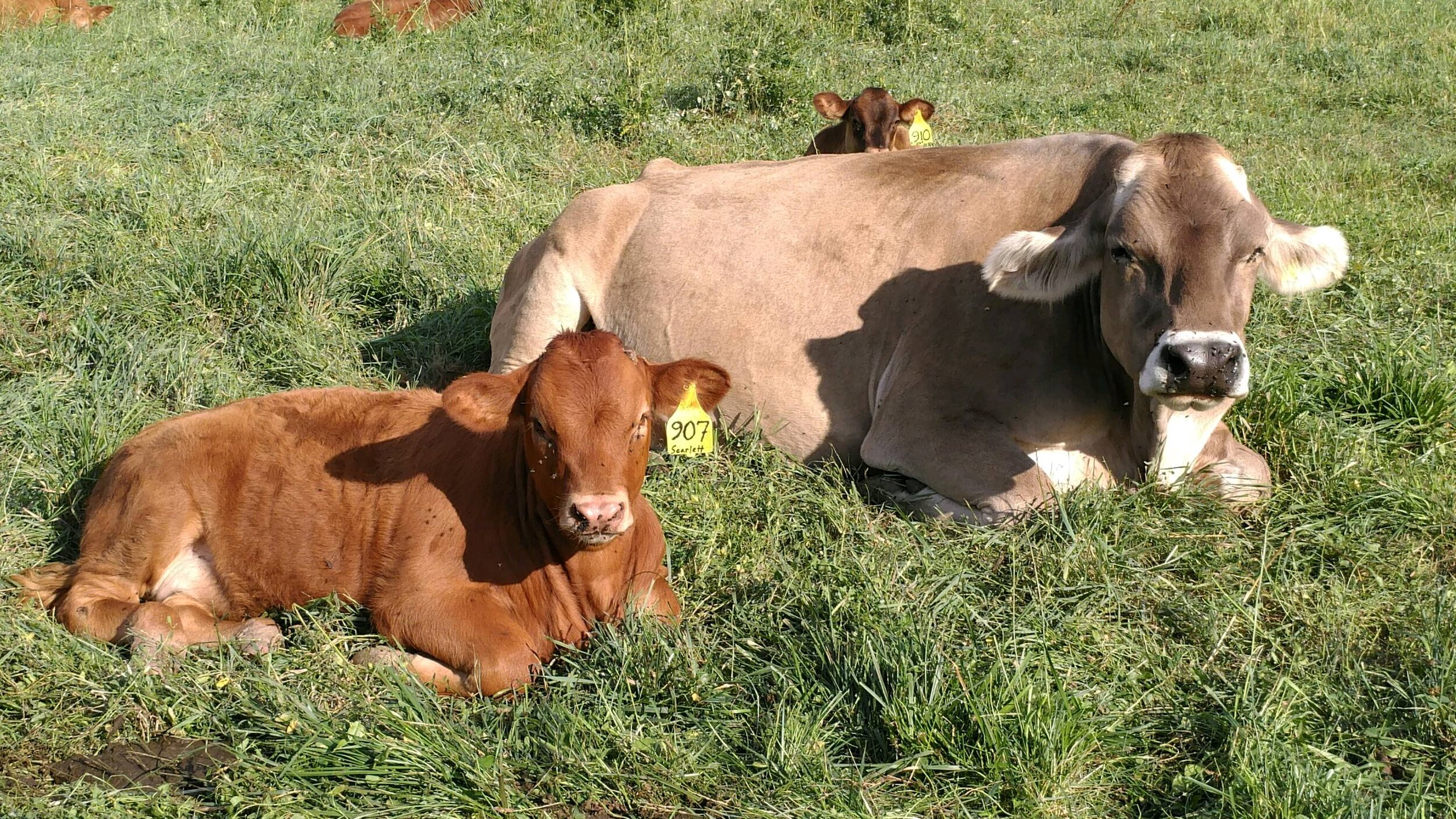Saint John’s mama and baby. Healthy pasture, healthy cows.
People often ask about the connection between what we eat and acne. There is a common myth that beef, dairy, meats, and other foods containing fat are the primary culprits in causes of acne.
If meat consumption contributes to acne, then is grass fed beef any different? Does it really make any difference from a greasy-skin-perspective, if beef is grain fed or grass fed? We absolutely think that there is a difference between grass fed and grain fed beef, as far as skin and overall health are concerned.
The key to understanding skin health is to remember the health and quality of our skin is downstream from the state of our overall health. Skin is the last organ to receive nutrition. This means that if someone is in a state of malnutrition, their body will ensure that every organ gets nutrition before their skin does.
Our skin health is a reflection of our overall health. Skin and other health issues may signify that we are missing key nutrients, are overtired or overstressed, inflammation is high, or that a hormonal or microbiome issue is at play.
Saint John’s organic pastures. The nutrition starts here.
Grass Fed Beef & Omega Fatty Acids
The truth is that not all fat is created equally. A greasy feeling can follow the consumption of many foods, but the healthy fat of grass fed beef will help support and heal your skin by providing your body with superb nutrition.
Healthy skin, and really, all aspects of health starts at the cellular level. When we have healthy cells, we can have healthy skin.
Every cell in our body is coated with a cellular membrane. This membrane is responsible for keeping the right nutrients and cellular parts in the cell and keeping unwanted compounds and free radicals out of the cell. The cellular membrane is primarily made of cholesterol and omega-3 fatty acids.
Free radicals in our cells do damage, causing inflammation. Inflammation manifests in adverse health outcomes, including acne.
Grass fed beef is significantly higher in omega-3 fatty acids and lower in omega-6 fatty acids. Omega-3 and omega-6 fatty acids are “essential fatty acids”, meaning that our bodies cannot produce them, so we must consume them through diet. These two essential fatty acids work together to support human health.
Most Western diets contain an excess of omega-6 fatty acids and a deficiency of omega-3 fatty acids. Omega-6 fatty acids are not necessarily harmful to our health, but omega-3 and omega-6 fatty acids must be consumed in an appropriate proportion. Grass fed beef supports our essential fatty acid requirement by its abundance of omega-3 fatty acids and low amount of omega-6 fatty acids.
Grass fed beef is an abundant source of conjugated linoleic acid (CLA). CLA is a polyunsaturated fatty acid found in ruminant animals (cows, sheep, etc.) that convert grass into nutrition through a prolonged digestion period.
CLA is known for being a powerful anti-inflammatory, and therefore can help alleviate inflammatory conditions like acne. For maximum CLA density in meat, it’s important to choose grass fed beef, as conventional grain fed beef is not a good source of CLA.
Saint John’s cows munching as the weather turns colder.
Grass Fed Beef: Glowing Skin
Grass fed beef is rich in acne-fighting, skin-supporting nutrients like vitamin A, vitamin E, anad zinc. The vitamin A in grass fed beef is in retinol form and is a primary contributing nutrient to glowing skin.
Vitamin A (the animal form of beta-carotene) is high in grass beef because the cow turns the beta-carotene from grass into vitamin A through its digestive and assimilative work. You may notice that the fat in grass fed beef steaks is more yellow in color while the fat of grain fed beef is closer to white (it’s very obvious on a cut like a NY strip steak).
This yellow color is a key sign of nutrient density for vitamin A. Vitamin A is highly bioavailable in grass fed beef, and it gives rich flavor to the beef as well.
Organic Grass Fed Beef: Free of Added Hormones
Many studies and stories show that acne and other skin issues are closely tied to hormonal conditions. Teenagers going through puberty and women going through hormonal changes often experience acne as a sign of hormonal change and possible imbalance.
Organic, grass fed beef supports hormon health in two primary ways. First, grass fed beef is an excellent source of zinc. Zinc is essential for the human endocrine system, and the endocrine system is what produces our hormones.
Second, organic grass fed beef is free of added hormones, something that is commonly given to conventionally raised cows. The hormones administered cause the cows to grow bigger and faster, and can improve the productivity (and profit) of a beef operation.
This productivity shortcut, however, comes with a cost. Cows fed growth hormones have higher IGF-1 (insulin-like growth factor 1) levels in the meat, and there is some evidence that this can contribute to cancer and other diseases. The hormone content is present in the meat, and this consumption of added hormone can contribute to hormonal imbalances.
In summary, grass fed beef supports our whole body health (and therefore skin health) by supplying us with a balanced ratio of omega-3 and omega-6 essential fatty acids to stop free radicals from entering a cell, conjugated linoleic acid to reduce existing inflammation, vitamin A for glowing skin, zinc for endocrine system support, and it’s free of potentially harmful added hormones. What’s not to like?
References


